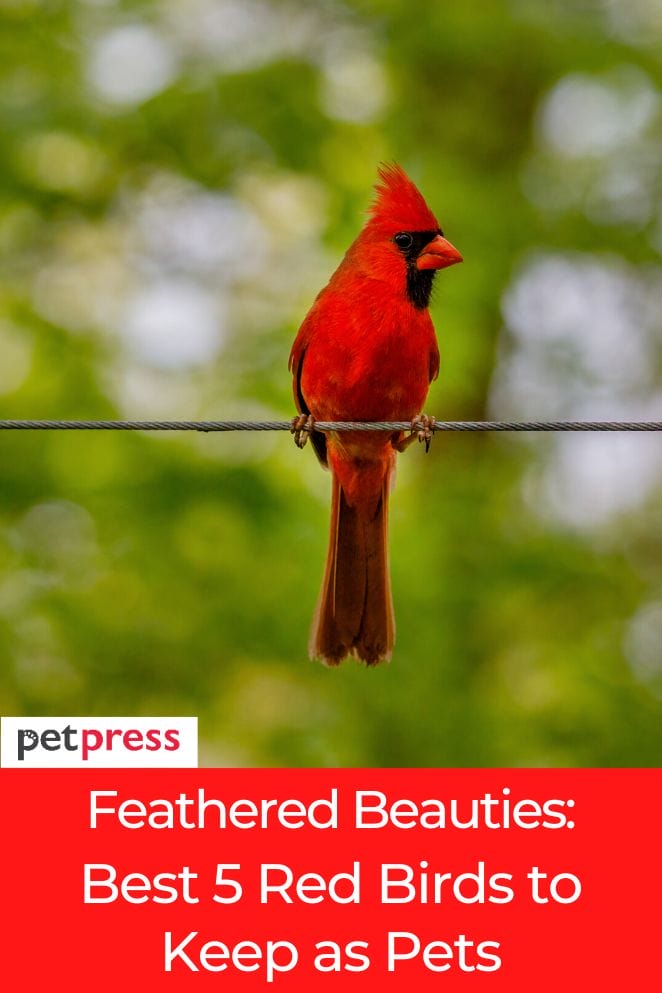
Enhancing your home’s ambiance with a vibrant touch?
Consider inviting the charm of a striking red bird into your space.
Not only are these birds visually captivating, but they also make delightful companions as pets.
This guide will introduce you to several popular red bird species suitable for pet keeping, providing insightful details to assist you in making an informed choice.
Let’s delve into the world of these colorful avian companions.
5 Best Red Birds to Keep as Pets
Scarlet Macaw
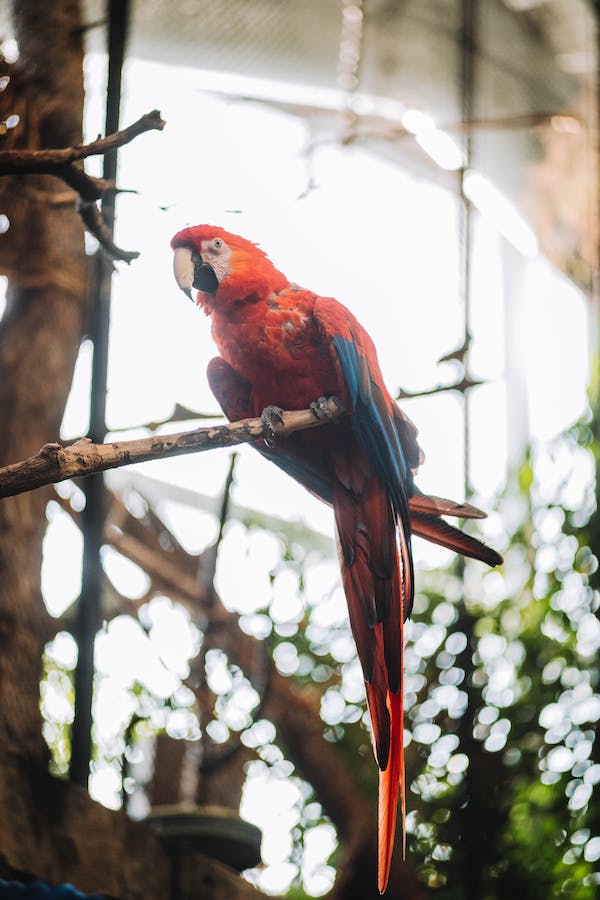
The Scarlet Macaw stands out with its vibrant red feathers adorned with splashes of blue and yellow on its wings.
Renowned for their playful and affectionate nature, these parrots can form strong bonds with their owners.
However, it’s essential to note that Scarlet Macaws require ample space for their active lifestyle and mental stimulation.
- Read also: Exploring the Vibrant World of Colorful Bird Species
- Read also: 10+ Interesting Bird Facts That Are Amazing And Will Surprise You
Bird overview
| Weight | 2.2 to 3.3 lbs |
| Length | 32 to 39 inches |
| Characteristics | Playful, affectionate, requires space and mental stimulation |
| Life Expectancy | 40 to 50 years |
African Red Bishop
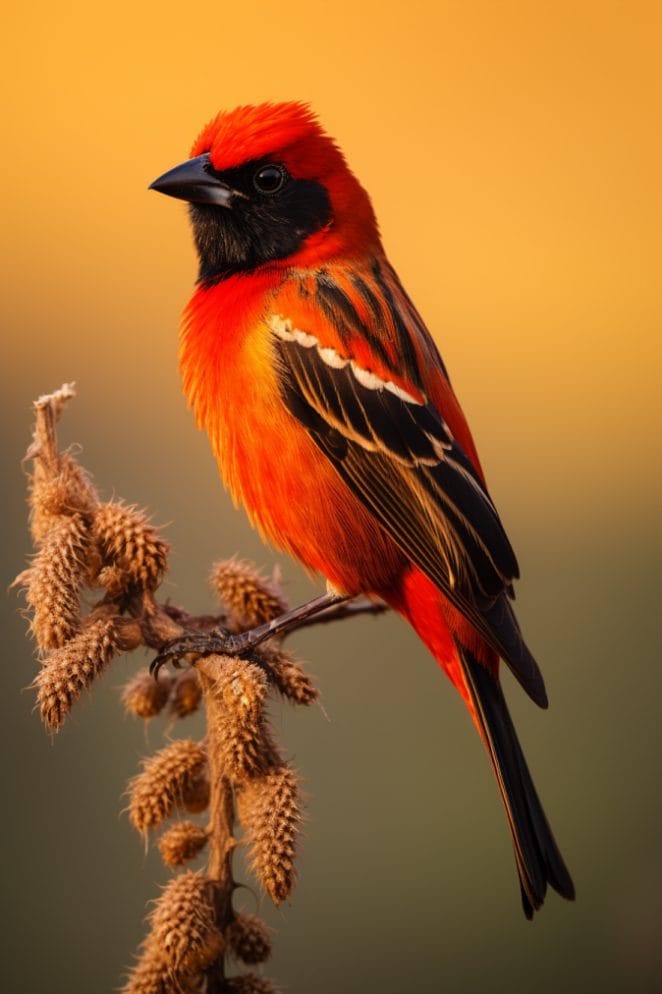
The African Red Bishop, also known as the Orange Bishop, is a smaller red bird distinguished by a black face and an orange beak.
These birds are relatively easy to care for, making them suitable for pet owners.
They thrive in spacious aviaries and can coexist harmoniously with other compatible bird species.
Bird overview
| Weight | 0.7 to 1.2 oz |
| Length | 4.7 to 6.7 inches |
| Characteristics | Relatively easy to care for, suitable for spacious aviaries, compatible with other birds |
| Life Expectancy | 5 to 10 years |
Red Factor Canary
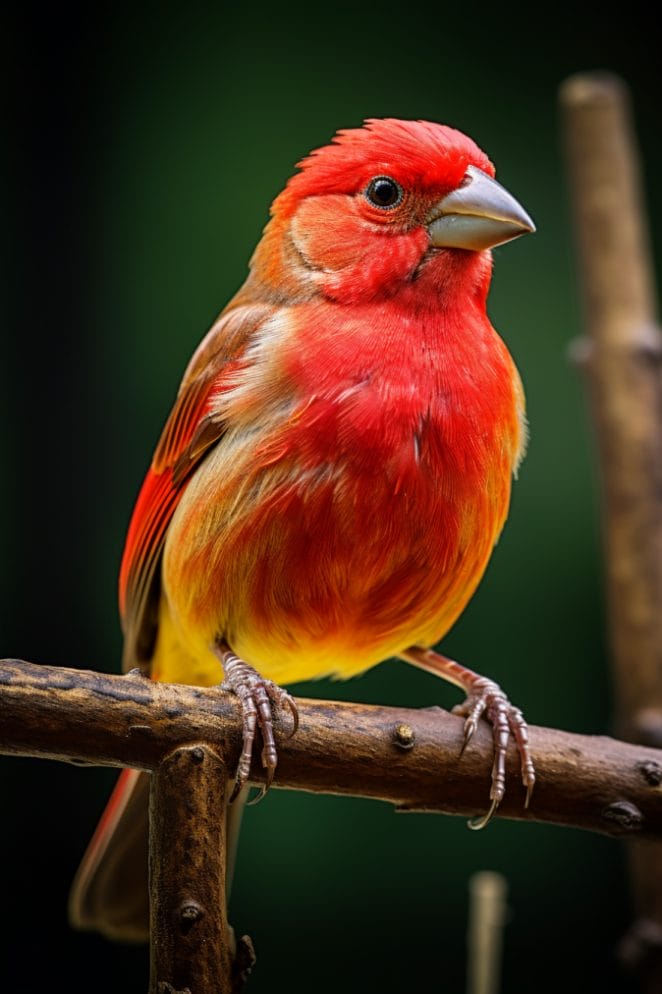
A popular choice among pet enthusiasts, the Red Factor Canary boasts stunning red plumage and a melodious song.
These birds are known for their low-maintenance requirements, making them suitable for those new to bird ownership.
A well-equipped cage with perches and toys will keep them happily engaged.
Bird overview
| Weight | 0.6 to 0.8 oz |
| Length | 4.7 to 8.3 inches |
| Characteristics | Low-maintenance, melodious song, suitable for well-equipped cages |
| Life Expectancy | 7 to 10 years |
Red Lory
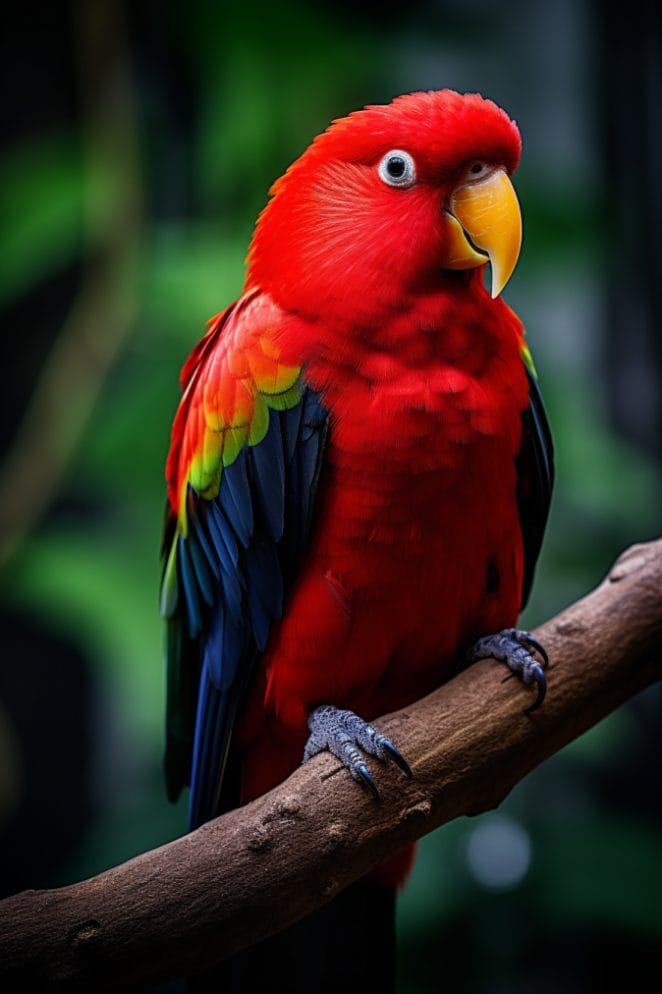
The Red Lory is a visually striking red parrot distinguished by its unique brush-tipped tongue.
With high energy levels, they require a specialized diet consisting of nectar and fruits.
Due to their demanding nature, Red Lories are best suited for experienced bird owners who can provide the necessary care and attention.
Bird overview
| Weight | 4.2 to 6.0 oz |
| Length | 10 to 12 inches |
| Characteristics | Highly energetic, specialized diet of nectar and fruits, best for experienced owners |
| Life Expectancy | 15 to 30 years |
Crimson Rosella
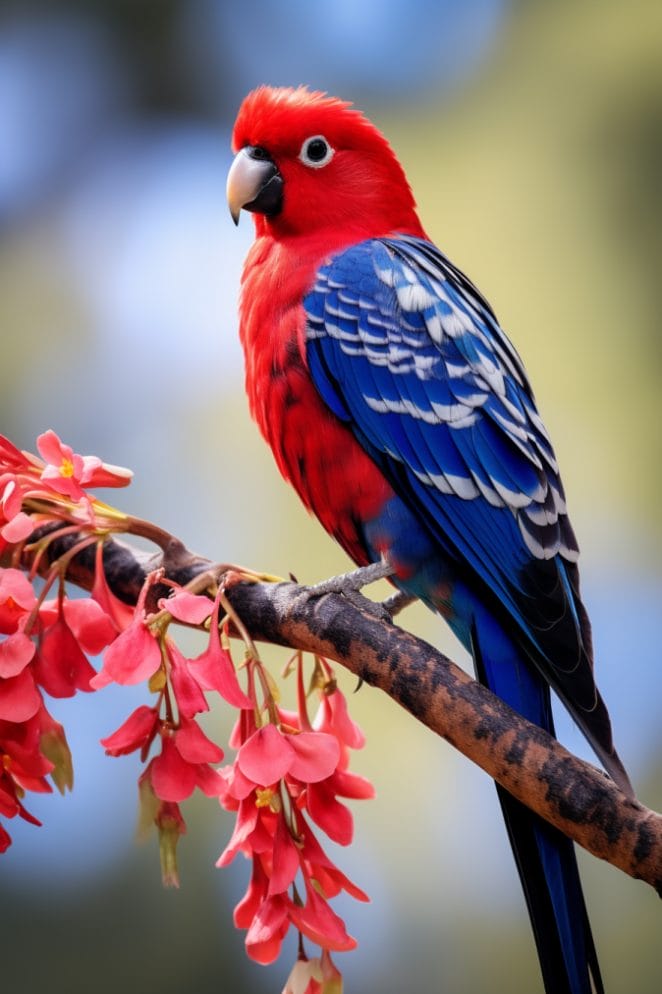
The Crimson Rosella is a colorful parrot featuring a mix of red, blue, and green feathers.
Intelligent and social, these birds thrive on interaction and mental stimulation.
To keep them happy, provide a variety of toys and ensure regular socialization to foster their well-being.
Bird overview
| Weight | 4.2 to 5.8 oz |
| Length | 10 to 14 inches |
| Characteristics |
Intelligent, social, thrives on interaction and mental stimulation
|
| Life Expectancy | 15 to 20 years |
What Are Some Challenges of Having Red Birds as Pets?
While red birds can make great pets, there are some challenges to consider before bringing one home.
Here are some of the challenges:
Specialized care
Certain red bird species, like the Red Lory, demand specialized care, particularly in their dietary needs.
Their diet often consists of nectar and fruits, requiring owners to invest time and effort into providing the right nutrition.
Additionally, these birds thrive in large enclosures, necessitating ample space for them to play, fly, and climb.
Noise Level
Some red bird species, including the vocal Scarlet Macaw, can be quite loud.
This might pose challenges, especially for individuals residing in apartments or close-knit neighborhoods.
The noise factor should be carefully considered to maintain harmony with neighbors and the living environment.
Long lifespan
A notable consideration is the extended lifespan of certain red bird species, which can live up to 40 years or more.
This longevity translates to a significant long-term commitment in terms of time, effort, and resources.
Potential owners must be prepared for the commitment involved in caring for a pet with a prolonged lifespan.
Aggression
Some red bird species, like the Crimson Rosella, can display aggressive behavior, making them challenging to tame and handle.
Understanding the temperament of the chosen species is crucial to managing their behavior and ensuring a positive relationship between the bird and its owner.
Legal restrictions
Legal considerations should not be overlooked, particularly with species like the Scarlet Macaw, which may be protected by law.
Owning such birds may require special permits, and it’s essential to research and comply with legal requirements before bringing a red bird home.
Welfare concerns
The welfare of pet birds, in general, is paramount.
Without proper housing, nutrition, and socialization, the well-being of red birds can be compromised.
Prospective owners must commit to providing a suitable environment that meets their pet’s physical and psychological needs.
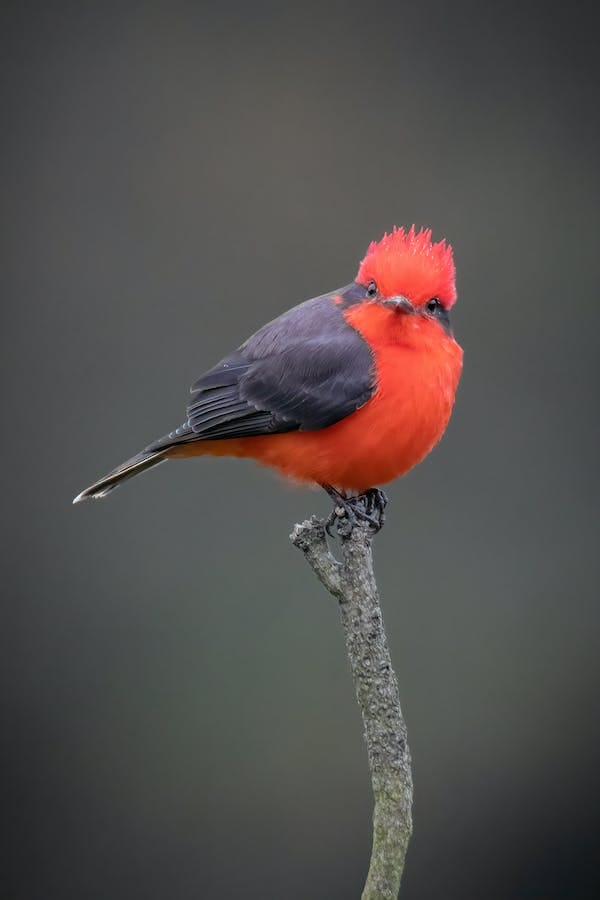
Some Training Tips for Red Birds as Pets
Training red birds as pets requires patience, consistency, and positive reinforcement. Here are some training tips:
Use positive reinforcement
Utilize positive reinforcement to encourage desired behaviors in your red bird.
Reward them promptly with high-value treats or verbal praise when they exhibit the behavior you are aiming for.
This creates a positive association, making them more likely to repeat the desired action.
Consider clicker training
Clicker training can be an effective method for reinforcing positive behavior in birds.
Using a clicker in conjunction with treats or praise helps your bird understand which behaviors lead to rewards.
Consistent use of the clicker enhances clarity in communication during training sessions.
Be patient
Recognize that different birds have varying learning speeds.
Some may quickly grasp new skills, while others might take more time.
Patience is crucial during training sessions, as frustration can confuse and frighten your bird.
Celebrate small successes and progress at a pace that suits your bird’s comfort level.
Make it part of your daily routine
Incorporate training into your daily routine to provide mental stimulation for your red bird.
Breaking the training into short sessions, around 10 minutes each, spread throughout the day helps maintain their interest and prevents boredom.
Maintain a consistent training schedule
Birds thrive on routine, so establish a consistent training schedule.
Aim to conduct training sessions around the same time each day, allowing your bird to anticipate and engage in the learning process.
Pay attention to your bird’s cues, pausing training if signs of sleepiness, fear, or aggression arise.
Avoid punishment
Positive reinforcement is more effective than punishment when training birds.
Birds are sensitive creatures, and punishing them during training can lead to fear and confusion.
Instead, focus on rewarding positive behaviors to create a trusting and positive learning environment.
- Read also: The Top 7 Types of Birds That Can Talk
- Read also: How To Stop A Bird From Squawking In 7 Easy Steps
Conclusion
Introducing a red bird into your family can infuse joy and vibrancy into your daily life.
However, it is crucial to conduct thorough research and comprehend the distinctive requirements of the bird species you have in mind.
Prioritize ensuring that you can furnish an appropriate environment and care for your potential feathered companion before reaching a decision.


GIPHY App Key not set. Please check settings